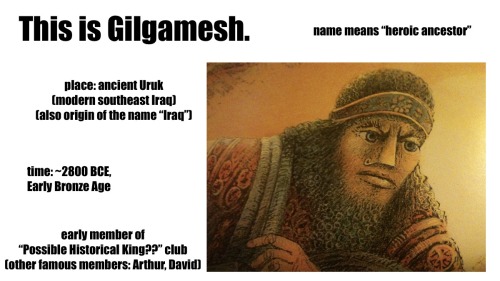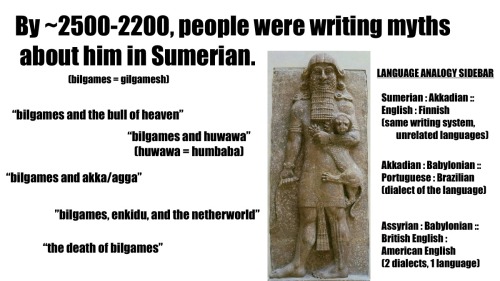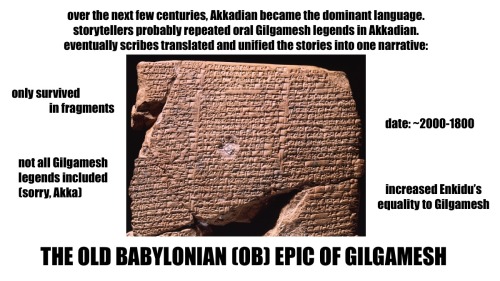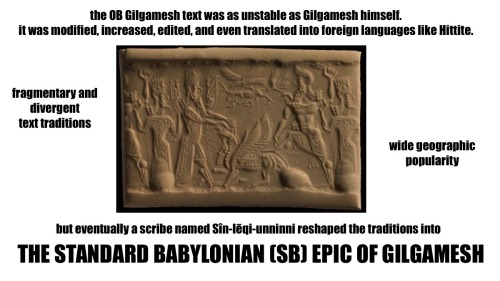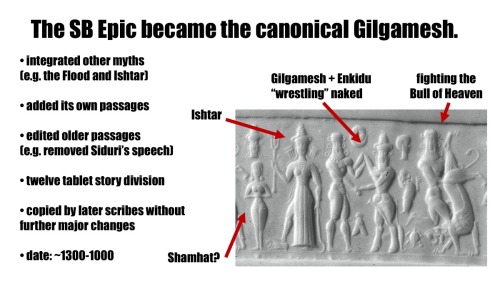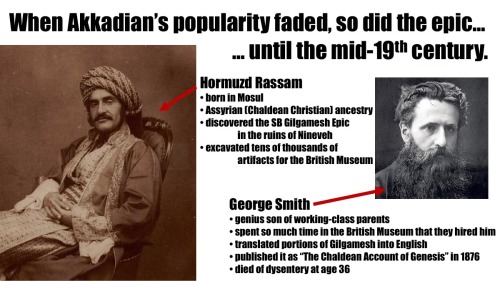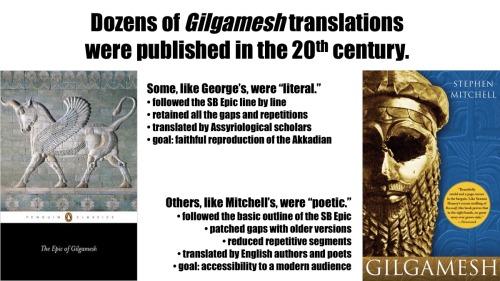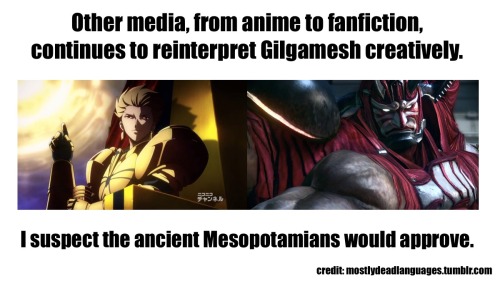A reblog of nerdy and quirky stuff that pique my interest.
291 posts
Latest Posts by philosophical-amoeba - Page 5
IT’S NATIONAL LIBRARY WEEK

HUZZAH! It is National Library Week, bookworms and library cats!!
And that means it is the perfect time of year to show some love to your local (and not local) Libraries, both in person and online. So, just as we took time to make a special post on Follow a Library Day last year, we’ve created ANOTHER master post to honor all the libraries we know so far on tumblr so that you can #followalibrary!!
Check out their tumblrs below and show them some love, bookworms! (Alphabetical by url)
@alachualibrary (The Alachua County Library District)
@alt-library (By Sacramento Public Library)
@aplibrary (Abilene Public Library)
@austinpubliclibrary (Austin Public Library)
@badgerslrc (The Klamath Community College’s Learning Research Center)
@bflteens (Baker Free Library’s Tumblr For Teens)
@bibliosanvalentino (Biblioteca San Valentino [San Valentino Library])
@biodivlibrary (Biodiversity Heritage Library)
@bodleianlibs (Bodleian Libraries)
@boonelibrary (Boone County Public Library)
@brkteenlib (Brookline Public Library Teen Services Department)
@californiastatelibrary (California State Library)
@cheshirelibrary (Cheshire Public Library)
@cityoflondonlibraries (City of London Libraries)
@cmclibraryteen (Cape May County Library’s Teen Services)
@cobblibrary (Cobb County Public Library System)
@cpl-archives (Cleveland Public Library Archives)
@cplsteens (Clearwater Public Library Teens)
@darienlibrary (Darien Library)
@dcpubliclibrary (DC Public Library)
@decaturpubliclibrary (Decatur Public Library)
@delawarelibrary (Delaware County District Library)
@detroitlib (Detroit Public Library Music, Arts & Literature Department)
@douglaslibraryteens (Douglas Library For Teens)
@dplteens (Danville Public Library Teens)
@escondidolibrary (Escondido Public Library)
@fontanalib (Fontana Regional Library)
@fppld-teens (Franklin Park Library Teens)
@friscolibrary (Frisco Public Library)
@gastonlibrary (Gaston County Public Library)
@glendaleteenlibrary (Glendale Public Library Teens)
@hpldreads (Havana Public Library District)
@hpl-teens (Homewood Public Library For Teens)
@kingsbridgelibraryteens (Kingsbridge Library Teens Advisory Group)
@lanelibteens (Lane Memorial Library Teen Services)
@lawrencepubliclibrary (Lawrence Public Library)
@marioncolibraries (Marion County Public Library System)
@mrcplteens (Mansfield/Richland County Public Library Teen Zone)
@myrichlandlibrary (Mansfield/Richland County Public Library)
@necclibrary (Northern Essex Community College Libraries)
@novipubliclibrary (Novi Public Library)
@nplteens (Nashua Public Library Teens)
@orangecountylibrarysystem (Orange County Library System)
@othmeralia (Othmer Library of Chemical History)
@petit-branch-library (Petit Branch Library)
@pflibteens (Pflugerville Public Library Teenspace)
@plainfieldlibrary (Plainfield Public Library District)
@royhartlibrary (RoyHart Community Library)
@safetyharborpubliclibrary (Safety Harbor Library Teen Zone)
@santamonicalibr (Santa Monica Public Library)
@schlowlibrary (Schlow Centre Region Library)
@smithsonianlibraries (Museum Library System)
@smlibrary (Sheppard Memorial Library)
@southeastlibrary (Southeast Branch Library)
@tampabaylibraryconsortium-blog (Tampa Bay Library Consortium)
@teenbookerie (Erie County Public Library For Teens)
@teencenterspl (The Smith Public Library Teen Center)
@teensfvrl (Fraser Valley Regional Library)
@teen-stuff-at-the-library (White Oak Library District)
@therealpasadenapubliclibrary (Pasadena Public Library)
@ucflibrary (University of Central Florida Library)
@uwmspeccoll (University of Wisconsin Milwaukee Libraries Special Collections)
@vculibraries (Virginia Commonwealth University Libraries)
@waynecountyteenzone (Wayne County Public Library’s Teen Space)
@wellingtoncitylibraries (Wellington City Libraries)
@widenerlibrary (Harvard’s Widener Library)
Whew! There’s a LOT of you. :) But we now this list is just getting started! Feel free to keep the library love going by adding any libraries we missed/don’t know of yet! (And if you’re not following US already, well, what better time to start than this week? ;) Eh? Eh?) And, of course, never hesitate to visit your Library in person. We love seeing you! :)
Happy National Library Week, library cats!
I am 100% convinced that “exit, pursued by a bear” is a reference to some popular 1590s meme that we’ll never be able to understand because that one play is the only surviving example of it.

1971 Japanese re-release poster for THE GRADUATE (Mike Nichols, USA, 1967)
Designer: unknown
Poster source: Heritage Auctions
Celebrating the films of storyboard artist Harold Michelson and researcher Lillian Michelson–the subjects of the upcoming HAROLD AND LILLIAN - A HOLLYWOOD LOVE STORY. This weekend, TCM will mark the 50th anniversary of The Graduate—a film that Harold storyboarded and contributed an iconic shot to—by screening a 4K restoration of the film in 700 theaters nationwide on April 23 and 26. Read more at the Harold and Lillian blog and find out where to see The Graduate here.
HAROLD AND LILLIAN opens next Friday at the Quad Cinema in New York.



Knowing the 20 Amino Acids is definitely a MUST for the 2015 MCAT
Amino acids that are usually negative (i.e. de-protonated) at physiological pH:
- Glutamate (E) Glu, and Aspartate (D) Asp
Amino acids that are usually positive (i.e. protonated) at physiological pH:
- Lysine (K) Lye, Arginine ® Arg
Histidine is sometimes charged at physiological pH.
physiological pH = 7, Neutral




George Michael was 23 when he sat for this interview, which has never been broadcast before.
He had just embarked on his solo career after leaving Wham!. During the conversation, George Michael talks about his sexuality and shedding his pop-ballad persona ala Careless Whisper. He reflects on the power of his fame, as he recalls the historical trip Wham! took to play in communist-China in 1985.
NEW from @blankonblank!
The Pirate Queen of the South China Sea
The Red Flag Fleet under Ching Shih’s rule went undefeated, despite attempts by Qing dynasty officials, the Portuguese navy, and the East India Company to vanquish it. After three years of notoriety on the high seas, Ching Shih finally retired in 1810 by accepting an offer of amnesty from the Chinese government. Ching Shih died in 1844, at the ripe old age of 69.At the dawn of the 1800s, a former prostitute from a floating brothel in the city of Canton was wed to Cheng I, a fearsome pirate who operated in the South China Sea in the Qing dynasty. Though the name under which we now know her, Ching Shih, simply means “Cheng’s widow,” the legacy she left behind far exceeded that of her husband’s. Following his death, she succeeded him and commanded over 1,800 pirate ships, and an estimated 80,000 men.
Her husband, Ching I, was the formidable commander of the Red Flag Fleet of pirate ships. He married a 26-year-old Ching Shih in 1801. She quickly took to the pirate life and when Ching I died six years later, Ching Shih wasn’t going to let Ching I’s adopted son, Cheung Po Tsai take over. Cheung Po Tsai, however, was more than just Ching Shih’s adopted son –- the young man had also been Ching I’s lover.
Keep reading

David in Singapore, Serious Moonlight Tour 1983
Photo © Denis O’Regan


March 24th 1944: The ‘Great Escape’
On this day in 1944, a group of Allied prisoners of war staged a daring escape attempt from the German prisoner of war camp at Stalag Luft III. This camp, located in what is now Poland, held captured Allied pilots mostly from Britain and the United States. In 1943, an Escape Committee under the leadership of Squadron Leader Roger Bushell of the RAF, supervised prisoners surreptitiously digging three 30 foot tunnels out of the camp, which they nicknamed ‘Tom’, ‘Dick’ and ‘Harry’. The tunnels led to woods beyond the camp and were remarkably sophisticated - lined with wood, and equipped with rudimentary ventilation and electric lighting. The successful construction of the tunnels was particularly impressive as the Stalag Luft III camp was designed to make it extremely difficult to tunnel out as the barracks were raised and the area had a sandy subsoil. ‘Tom’ was discovered by the Germans in September 1943, and ‘Dick’ was abandoned to be used as a dirt depository, leaving ‘Harry’ as the prisoners’ only hope. By the time of the escape, American prisoners who had assisted in tunneling had been relocated to a different compound, making the escapeees mostly British and Commonwealth citizens. 200 airmen had planned to make their escape through the ‘Harry’ tunnel, but on the night of March 24th 1944, only 76 managed to escape the camp before they were discovered by the guards. However, only three of the escapees - Norwegians Per Bergsland and Jens Müller and Dutchman Bram van der Stok - found their freedom. The remaining 73 were recaptured, and 50 of them, including Bushell, were executed by the Gestapo on Adolf Hitler’s orders, while the rest were sent to other camps. While the escape was generally a failure, it helped boost morale among prisoners of war, and has become enshrined in popular memory due to its fictionalised depiction in the 1963 film The Great Escape.
“Three bloody deep, bloody long tunnels will be dug – Tom, Dick, and Harry. One will succeed!” - Roger Bushell

No. 2 Construction Battalion
Fighting for a country that didn’t want them.
On March 25 1917, Canada’s first and only black military unit left Halifax harbor for the Western Front. Six hundred soldiers, mostly from Nova Scotia, formed up as No. 2 Construction Battalion. Many had been trying to enlist since 1914, but winning this privilege had been an up-hill fight: for two years military authorities had turned down black recruits, telling them “This is a white man’s war.”
Finally, in 1916, Canada allowed black recruits entry into a segregated united of laborers. An additional 165 African-Americans crossed the border to join them, creating a full complement of 600 men. Winning the struggle to join up hardly ended discrimination. Except for the reverend, all officers were white, and even when they went to board their transport ship on March 25 the captain initially refused to let them on, saying that he would not let them travel on the same vessel as white soldiers.

The recruits hoped to be allowed to fight when they reached France, but instead the Canadian Expediotnary Force immediately downgraded them from a battalion to a company and assigned them to fell trees and prepare positions for white soldiers. They were not ever even issued with rifles. Their work was tedious and demoralizing, and many considered themselves failures even as they suffered casualties from artillery shells and poison gas.
The unit returned to Canada in 1919, but received no fanfare upon arrival. Much like America’s black soldiers, they returned to a country that did not value them or their sacrifice and actively oppressed their rights. Most of these veterans returned to poverty and unemployment. When they finally had their first reunion in 1982, only nine could attend from twenty known survivors. Their legacy and sacrifice has been revived since then. Although very few men were allowed the chance to serve, they began the first crack in the Canadian military’s institutionalized racism.


Ornithorhynchus anatinus - Detail of Bill
The monotremes (egg-laying mammals) are the only mammalia with any sort of electroreception ability, and the platypus’ ability is far stronger than that of the echidna. They use neither sight nor smell while hunting for their food, which consists of small crustaceans and molluscs buried in lakes and slow-moving river bottoms. The platypus finds its food by sweeping its broad bill back and forth along the sediment, and the receptors that line the front and part of the sides of the bill pick up the electric field given off by its prey. It then uses its paws (with the flipper-ish part folded back) to dig out its snack.
Illustrations from the Proceedings of the Zoological Society of London, Vol. I: Mammalia. 1848-1860.



Throughout the Watergate scandal, Richard Nixon and his supporters accused the press of being biased against his administration. In response to the criticism, Time, which had done significant investigative work on Watergate, took a moment for self-reflection with a July 8, 1974, cover story examining the press’ role in the event. Weighing the notion that the press had become too involved for its own good, the magazine still concluded that further investigation was necessary:
“If the press were to stop digging, analyzing and attempting to keep the record straight, the investigative momentum could easily falter once more. The press can help assure that the constitutional process continues to function. After all that has happened, the country is entitled to a definitive verdict.”
Nevertheless, accusations persisted that Time and other publications were merely pursuing a liberal agenda. In February 1976 Reed Irvine and his conservative organization Accuracy in Media bought a full-page ad in the Washington Post to print a story alleging that Democratic National Committee officials knew about plans to break into the Watergate offices beforehand. The ad implied that the DNC was something other than an innocent victim and that the press had refused to make this assertion for partisan reasons. In this memo from Time’s Washington Bureau correspondent Hays Gorey to his editors, Gorey outlines the investigation done into the potential story and defends the consensus among his colleagues that it did not merit publication. He writes:
“I’m sure Reed Irvine can wow audiences by telling this story and claiming it is news being covered up. But where are his facts? Hundreds of Watergate stories went unwritten and unpublished because there were no facts to support them. This is one.“
Time July 8, 1974 cover reprint. Time Inc. Records. Editor-in-Chief: Hedley Donovan Files: Subject Files: 1959-1979: Time: Bias. New-York Historical Society.
Hays Gorey to Hedley Donovan, Henry Grunwald, and D. Duncan. February 27, 1976. Time Inc. Records. Editor-in-Chief: Hedley Donovan Files: Subject Files: 1959-1979: [Time: Bias: Kennedy and Nixon]. New-York Historical Society.
Processing of the Time Inc. Archive is made possible through the generous support of the Henry Luce Foundation

The U.S. space agency launched a new web-based search engine for much of its catalog of images, video and audio files, which you can browse by keyword and metadata, so that you never have to remember the dismal reality that you’re earthbound ever again.

Four years of failed harvests (1695, 1696, and 1698–99) resulted in severe famine and depopulation, particularly in the north of Scotland. Starvation killed 5 to 15 percent of the Scottish population, but in areas such as Aberdeenshire, death rates reached 25 percent.
Rarely has a natural disaster had such wide-ranging historical consequences as did the famine that struck Scotland in the mid-1690s. Little more than a decade later, as Scotland’s social elites despaired about their nation’s grinding poverty and profound structural weakness, the country’s Parliament finally voted away its age-old independence in favor of unification with England, previously Scotland’s bitterest and most enduring enemy.
The author of this sermon was a very colorful figure. A Scottish Presbyterian minister denounced as a rebel in 1674, he was restored next year but arrested again the following February. Later he was arrested for refusing to pray for the Prince of Wales, but again released. His matrimonial adventures were no less robust than his professional career. He was married seven times and fathered at least nine children.
David Williamson (1636- 1706). Scotland’s sin, danger, and duty: faithfully represented in a sermon preach’d at the West-Kirk, August 23d, 1696: being a solemn fast-day upon occasion of the great dearth and famine. Rare BT162.F3 W54 1720







Southeast Asia’s Ramayana Epic Versions.
The Ramayana epic is well known in many parts of Asia as the Homer’s Iliad is to the West. It is a story with many versions of the tale, told throughout South and Southeast Asia and shows the history and influence of Hinduism throughout the Southeast Asian region. Here is a list of the well known versions from different countries in SEA. Some differ and have been adapted to the local culture but all tell the same tale.
1.) Indonesia ~ Kakawin Ramayana
Kakawin Ramayana is an Old Javanese rendering of the Sanskrit Ramayana in kakawin meter. It is believed to have been written in Central Java (modern Indonesia) in approximately 870 AD during the era of Medang Kingdom. Kakawin Rāmâyaṇa is a so-called kakawin, the Javanese form of kāvya, a poem modeled on traditional Sanskrit meters. Among the Javanese, Kakawin Ramayana has always been considered the pinnacle of artistic expression. The large number of preserved manuscripts attest to it popularity and adaptation. It is the lengthiest of all the Old Javanese kakawins of the Hindu-Buddhist period of Java.
2.) Myanmar ~ Yama Zatdaw
Yama Zatdaw is the Burmese version of the Ramayana. There are nine known pieces of the Yama Zatdaw in Myanmar. The Burmese name for the story itself is Yamayana, while zatdaw refers to the acted play or being part of jataka tales of Theravada Buddhism. The Yama Zatdaw was introduced by oral tradition during King Anawratha’s reign although it was not known clearly whether the story was Valmiki’s Sanskrit epic Ramayana or not. In the Nathlaung Temple, the Visnu temple, within the walls of old city Bagan, there are some stone sculptures, one of which is Ramachandra. Based on Burmese literature, at least, Hanuman has been known in Burma definitely before 1527 AD.
3) Thailand ~ Ramakien
The Ramakien (รามเกียรติ์, “Glory of Rama”, sometimes also spelled Ramakien) is Thailand’s national epic, derived from the Hindu epic Ramayana. The word is derived from Sanskrit word Ramakhyan (Ram + Akhyan) where Akhyan means a long story or epic. A number of versions of the epic were lost in the destruction of Ayutthaya in 1767. Three versions currently exist, one of which was prepared in 1797 under the supervision of (and partly written by) King Rama I. His son, Rama II, rewrote some parts of his father’s version for khon drama. The work has had an important influence on Thai literature, art and drama (both the khon and nang dramas being derived from it). While the main story is identical to that of the Ramayana, many other aspects were transposed into a Thai context, such as the clothes, weapons, topography, and elements of nature, which are described as being Thai in style. Although Thailand is considered a Theravada Buddhist society, the Hindu mythology latent in the Ramakien serves to provide Thai legends with a creation myth, as well as representations of various spirits which complement beliefs derived from Thai animism. A painted representation of the Ramakian is displayed at Bangkok’s Wat Phra Kaew, and many of the statues there depict characters from it.
4.) Philippines ~ Darangen
The Philippines is one of the last places in Southeast Asia where most people wouldn’t expect influences of Hinduism & Buddhism in the culture and country. Yet despite heavy colonization and Westernization, many parts of the Philippines were Indianized and practiced a form of Hinduism & Buddhism as the rest of Southeast Asia. Traces of that history can still be found in artifacts recovered and in epics. One such epic is the Darangen of the Maranao. Darangen comes from two root words, meaning “to narrate in song.” The Darangen was first told in the fourteenth century A.D. The Darangen Epic of the Maranaos, including the Maharadia Rawana, is an indigenized version of the Ramayana. Most people believe that the popular traditional Singkil dance is indigenous to the Maguindanao ethnic group or to the Maranao ethnic group in Mindanao or both. But in fact, the Singkil is a Maguindanao and Maranao interpretation of the Ramayana epic, as retold in the Darangen Epic, where the original polytheistic accounts were restated and transformed to conform to monotheistic Islam to which the Maranaos and Maguindanaos adhere. Note,however, that the Singkil is not religious and it is not Muslim. It is a secular dance of the Maranaos and the Maguindanaos, the majority of whom are Muslims.
5.) Laos ~ Phra Lak Phra Lam
Phra Lak Phra Ram is the national epic of the Lao people, and is adapted from Valmiki’s Hindu epic, the Ramayana. Similar to some Malay versions of the Hikayat Seri Rama, the epic has lost the association with Hinduism and is instead considered a Jataka Story, a previous lifetime of the Buddha. It is also very popular in Northeastern Thailand, or Isan, a region of Thailand mostly populated by ethnic Lao and formerly part of Lanxang.
6.) Malaysia ~ Hikayat Seri Rama
Hikayat Seri Rama is the Malay literary adaptation of the Hindu Ramayana epic. The main story remains the same as the original Sanskrit version but some aspects of it were slightly modified to a local context such as the spelling and pronunciation of names. Numerous branch stories had also been developed as accretions to or extensions of this epic with the upgrading of minor characters to major ones, or the invention of totally new characters. For example, Malay writers and storytellers have produced variations in which Laksmana (Lakshman) plays a larger role, sometimes becoming more important than Rama the elder prince much like the Lao Phra Lak Phra Lam. Rama, although righteous and virtuous, was perceived to be weak and his character is often moved to the background while the younger Laksmana is admired for his courage and willingness to react decisively.
7.) Cambodia ~ Reamker
Reamker is a Cambodian epic poem, based on the Sanskrit’s Ramayana epic. The name means “Glory of Rama”. It adapts the Hindu ideas to Buddhist themes and shows the balance of good and evil in the world. More than just a reordering of the epic tale, the Reamker is a mainstay of the royal ballet’s repertoire. Like the Ramayana, it is a philosophical allegory, exploring the ideals of justice and fidelity as embodied by the protagonists, Prince Rama and Queen Sita. The epic is well known among the Khmer people for its portrayal in Khmer dance theatre, called the Lkhaon, in various festivals across Cambodia. Scenes from the Reamker are painted on the walls of the Royal Palace in Khmer style, and its predecessor is carved into the walls of the Angkor Wat and Banteay Srei temples. It is considered an integral part of Cambodian culture. The Reamker differs from the original Ramayana in some ways, featuring additional scenes and emphasis on Hanuman and Sovanna Maccha. In the Reamker, issues of trust, loyalty, love, and revenge play out in dramatic encounters among princes and giants, monkeys and mermaids, and a forlorn princess. Though it is understood that Preah Ream is an incarnation of the Hindu god Vishnu, his characteristics and those of the others in the story are interpreted in Cambodia as those of mere mortals, not of the gods as is the case in India. The complex interplay of strengths and weaknesses, though couched in episodes lined with magic, nonetheless represents a decidedly human social behavior.
Photo Sources: [x], [x], [x], [x], [x], [x], [x]










My boyfriend, @inlove-with-a-spine, is very uninformed about Southeast Asian fruits (he only knows durian) which inspired me to find these online.
I’m pretty sure the names are different in other Southeast Asian countries, though.
From left to right (in Indonesian):
Duku
Jambu monyet
Jeruk
Lengkeng
Kedondong
Manggis
Rambutan
Nangka
Salak
Sawo
Jumps, Explained
So, going by the tags on my recent jump gifsets, the difference between jumps is apparently still a source of great bewilderment for some people. Now I could link you to some excellent posts on the topic, but since I am, as usual, an extra lil piece of dirt with too much work to do and a lifetime’s worth of procrastination, I’ve decided to put together my own layman’s guide to identifying figure skating jumps (stressed on the layman part).
First, here be a flowchart, since everybody loves flowcharts, right?

If the flowchart works as intended and you can now tell the jumps apart, great! If you need a bit more explanation and illustration, read on.
Keep reading
List of medieval European scientists
Anthemius of Tralles (ca. 474 – ca. 534): a professor of geometry and architecture, authored many influential works on mathematics and was one of the architects of the famed Hagia Sophia, the largest building in the world at its time. His works were among the most important source texts in the Arab world and Western Europe for centuries after.
John Philoponus (ca. 490–ca. 570): also known as John the Grammarian, a Christian Byzantine philosopher, launched a revolution in the understanding of physics by critiquing and correcting the earlier works of Aristotle. In the process he proposed important concepts such as a rudimentary notion of inertia and the invariant acceleration of falling objects. Although his works were repressed at various times in the Byzantine Empire, because of religious controversy, they would nevertheless become important to the understanding of physics throughout Europe and the Arab world.
Paul of Aegina (ca. 625–ca. 690): considered by some to be the greatest Christian Byzantine surgeon, developed many novel surgical techniques and authored the medical encyclopedia Medical Compendium in Seven Books. The book on surgery in particular was the definitive treatise in Europe and the Islamic world for hundreds of years.
The Venerable Bede (ca. 672–735): a Christian monk of the monasteries of Wearmouth and Jarrow who wrote a work On the Nature of Things, several books on the mathematical / astronomical subject of computus, the most influential entitled On the Reckoning of Time. He made original discoveries concerning the nature of the tides and his works on computus became required elements of the training of clergy, and thus greatly influenced early medieval knowledge of the natural world.
Rabanus Maurus (c. 780 – 856): a Christian monk and teacher, later archbishop of Mainz, who wrote a treatise on Computus and the encyclopedic work De universo. His teaching earned him the accolade of "Praeceptor Germaniae," or "the teacher of Germany."
Abbas Ibn Firnas (810 – 887): a polymath and inventor in Muslim Spain, made contributions in a variety of fields and is most known for his contributions to glass-making and aviation. He developed novel ways of manufacturing and using glass. He broke his back at an unsuccessful attempt at flying a primitive hang glider in 875.
Pope Sylvester II (c. 946–1003): a Christian scholar, teacher, mathematician, and later pope, reintroduced the abacus and armillary sphere to Western Europe after they had been lost for centuries following the Greco-Roman era. He was also responsible in part for the spread of the Hindu-Arabic numeral system in Western Europe.
Maslamah al-Majriti (died 1008): a mathematician, astronomer, and chemist in Muslim Spain, made contributions in many areas, from new techniques for surveying to updating and improving the astronomical tables of al-Khwarizmi and inventing a process for producing mercury oxide.[citation needed] He is most famous, though, for having helped transmit knowledge of mathematics and astronomy to Muslim Spain and Christian Western Europe.
Abulcasis (936-1013): a physician and scientist in Muslim Spain, is considered to be the father of modern surgery. He wrote numerous medical texts, developed many innovative surgical instruments, and developed a variety of new surgical techniques and practices. His texts were considered the definitive works on surgery in Europe until the Renaissance.
Constantine the African (c. 1020&–1087): a Christian native of Carthage, is best known for his translating of ancient Greek and Roman medical texts from Arabic into Latin while working at the Schola Medica Salernitana in Salerno, Italy. Among the works he translated were those of Hippocrates and Galen.
Arzachel (1028–1087): the foremost astronomer of the early second millennium, lived in Muslim Spain and greatly expanded the understanding and accuracy of planetary models and terrestrial measurements used for navigation. He developed key technologies including the equatorium and universal latitude-independent astrolabe.
Avempace (died 1138): a famous physicist from Muslim Spain who had an important influence on later physicists such as Galileo. He was the first to theorize the concept of a reaction force for every force exerted.
Adelard of Bath (c. 1080 – c. 1152): was a 12th-century English scholar, known for his work in astronomy, astrology, philosophy and mathematics.
Avenzoar (1091–1161): from Muslim Spain, introduced an experimental method in surgery, employing animal testing in order to experiment with surgical procedures before applying them to human patients.[4] He also performed the earliest dissections and postmortem autopsies on both humans as well as animals.
Robert Grosseteste (1168–1253): Bishop of Lincoln, was the central character of the English intellectual movement in the first half of the 13th century and is considered the founder of scientific thought in Oxford. He had a great interest in the natural world and wrote texts on the mathematical sciences of optics, astronomy and geometry. In his commentaries on Aristotle's scientific works, he affirmed that experiments should be used in order to verify a theory, testing its consequences. Roger Bacon was influenced by his work on optics and astronomy.
Albert the Great (1193–1280): Doctor Universalis, was one of the most prominent representatives of the philosophical tradition emerging from the Dominican Order. He is one of the thirty-three Saints of the Roman Catholic Church honored with the title of Doctor of the Church. He became famous for his vast knowledge and for his defence of the pacific coexistence between science and religion. Albert was an essential figure in introducing Greek and Islamic science into the medieval universities, although not without hesitation with regard to particular Aristotelian theses. In one of his most famous sayings he asserted: "Science does not consist in ratifying what others say, but of searching for the causes of phenomena." Thomas Aquinas was his most famous pupil.
John of Sacrobosco (c. 1195 – c. 1256): was a scholar, monk, and astronomer (probably English, but possibly Irish or Scottish) who taught at the University of Paris and wrote an authoritative and influential mediaeval astronomy text, the Tractatus de Sphaera; the Algorismus, which introduced calculations with Hindu-Arabic numerals into the European university curriculum; the Compotus ecclesiasticis on Easter reckoning; and the Tractatus de quadrante on the construction and use of the astronomical quadrant.
Jordanus de Nemore (late 12th, early 13th century): was one of the major pure mathematicians of the Middle Ages. He wrote treatises on mechanics ("the science of weights"), on basic and advanced arithmetic, on algebra, on geometry, and on the mathematics of stereographic projection.
Villard de Honnecourt (fl. 13th century): a French engineer and architect who made sketches of mechanical devices such as automatons and perhaps drew a picture of an early escapement mechanism for clockworks.
Roger Bacon (1214–94): Doctor Admirabilis, joined the Franciscan Order around 1240 where, influenced by Grosseteste, Alhacen and others, he dedicated himself to studies where he implemented the observation of nature and experimentation as the foundation of natural knowledge. Bacon wrote in such areas as mechanics, astronomy, geography and, most of all, optics. The optical research of Grosseteste and Bacon established optics as an area of study at the medieval university and formed the basis for a continuous tradition of research into optics that went all the way up to the beginning of the 17th century and the foundation of modern optics by Kepler.[8]
Ibn al-Baitar (died 1248): a botanist and pharmacist in Muslim Spain, researched over 1400 types of plants, foods, and drugs and compiled pharmaceutical and medical encyclopedias documenting his research. These were used in the Islamic world and Europe until the 19th century.
Theodoric Borgognoni (1205-1296): was an Italian Dominican friar and Bishop of Cervia who promoted the uses of both antiseptics and anaesthetics in surgery. His written work had a deep impact on Henri de Mondeville, who studied under him while living in Italy and later became the court physician for King Philip IV of France.
William of Saliceto (1210-1277): was an Italian surgeon of Lombardy who advanced medical knowledge and even challenged the work of the renowned Greco-Roman surgeon Galen (129-216 AD) by arguing that allowing pus to form in wounds was detrimental to the health of he patient.
Thomas Aquinas (1227–74): Doctor Angelicus, was an Italian theologian and friar in the Dominican Order. As his mentor Albert the Great, he is a Catholic Saint and Doctor of the Church. In addition to his extensive commentaries on Aristotle's scientific treatises, he was also said to have written an important alchemical treatise titled Aurora Consurgens. However, his most lasting contribution to the scientific development of the period was his role in the incorporation of Aristotelianism into the Scholastic tradition.
Arnaldus de Villa Nova (1235-1313): was an alchemist, astrologer, and physician from the Crown of Aragon who translated various Arabic medical texts, including those of Avicenna, and performed optical experiments with camera obscura.
John Duns Scotus (1266–1308): Doctor Subtilis, was a member of the Franciscan Order, philosopher and theologian. Emerging from the academic environment of the University of Oxford. where the presence of Grosseteste and Bacon was still palpable, he had a different view on the relationship between reason and faith as that of Thomas Aquinas. For Duns Scotus, the truths of faith could not be comprehended through the use of reason. Philosophy, hence, should not be a servant to theology, but act independently. He was the mentor of one of the greatest names of philosophy in the Middle Ages: William of Ockham.
Mondino de Liuzzi (c. 1270-1326): was an Italian physician, surgeon, and anatomist from Bologna who was one of the first in Medieval Europe to advocate for the public dissection of cadavers for advancing the field of anatomy. This followed a long-held Christian ban on dissections performed by the Alexandrian school in the late Roman Empire.
William of Ockham (1285–1350): Doctor Invincibilis, was an English Franciscan friar, philosopher, logician and theologian. Ockham defended the principle of parsimony, which could already be seen in the works of his mentor Duns Scotus. His principle later became known as Occam's Razor and states that if there are various equally valid explanations for a fact, then the simplest one should be chosen. This became a foundation of what would come to be known as the scientific method and one of the pillars of reductionism in science. Ockham probably died of the Black Plague. Jean Buridan and Nicole Oresme were his followers.
Jacopo Dondi dell'Orologio (1290-1359): was an Italian doctor, clockmaker, and astronomer from Padua who wrote on a number of scientific subjects such as pharmacology, surgery, astrology, and natural sciences. He also designed an astronomical clock.
Richard of Wallingford (1292-1336): an English abbot, mathematician, astronomer, and horologist who designed an astronomical clock as well as an equatorium to calculate the lunar, solar and planetary longitudes, as well as predict eclipses.
Jean Buridan (1300–58): was a French philosopher and priest. Although he was one of the most famous and influent philosophers of the late Middle Ages, his work today is not renowned by people other than philosophers and historians. One of his most significant contributions to science was the development of the theory of impetus, that explained the movement of projectiles and objects in free-fall. This theory gave way to the dynamics of Galileo Galilei and for Isaac Newton's famous principle of Inertia.
Guy de Chauliac (1300-1368): was a French physician and surgeon who wrote the Chirurgia magna, a widely read publication throughout medieval Europe that became one of the standard textbooks for medical knowledge for the next three centuries. During the Black Death he clearly distinguished Bubonic Plague and Pneumonic Plague as separate diseases, that they were contagious from person to person, and offered advice such as quarantine to avoid their spread in the population. He also served as the personal physician for three successive popes of the Avignon Papacy.
John Arderne (1307-1392): was an English physician and surgeon who invented his own anesthetic that combined hemlock, henbane, and opium. In his writings, he also described how to properly excise and remove the abscess caused by anal fistula.
Nicole Oresme (c. 1323–82): was one of the most original thinkers of the 14th century. A theologian and bishop of Lisieux, he wrote influential treatises in both Latin and French on mathematics, physics, astronomy, and economics. In addition to these contributions, Oresme strongly opposed astrology and speculated about the possibility of a plurality of worlds.
Giovanni Dondi dell'Orologio (c. 1330-1388): was a clockmaker from Padua, Italy who designed the astarium, an astronomical clock and planetarium that utilized the escapement mechanism that had been recently invented in Europe. He also attempted to describe the mechanics of the solar system with mathematical precision.






If this Tibetan padlock looks massive that is because it is! And it has not one but THREE equally ginormous keys to open it! It is definitely a very intriguing padlock and indeed something of a puzzle as all three keys must be fitted simultaneously for it to open. There is one lock at the top underneath a panel, another on the side, and a third under a hinged panel on the back. Quite impressive!
We think it dates from the late nineteenth or early twentieth century and was purchased for the museum by Emslie Horniman, who was the son of our founder Frederick Horniman.
Object no. 13.223

BHL Book Feature: The Birds of Singapore Island
Our book feature this week is The Birds of Singapore Island (1927), co-authored by John Alexander Strachey Bucknill and Frederick Nutter Chase with SciArt by Gerald Aylmer Levett-Yeats, and published by the Raffles Museum. This work is the first book on the birds of Singapore!
Our featured illustration is a Greater Racket-tailed Drongo (Dicrurus paradiseus platurus). This book is written in an informal, non-scientific style to appeal to tourists and bird enthusiasts, and the description of the Greater Racket-tailed Drongo is a good example of this writing style.

All this week, we will be sharing several of the 31 plates from The Birds of Singapore Island, which was digitized for BHL by National Library Board, Singapore. You can view all of the plates from this work in our Flickr album, and check out our blog post, which was written by Ong Eng Chuan, Senior Librarian of the National Library Board, Singapore.
Molecule of the Day: VX


VX (C11H26NO2PS) is a colourless, odourless, oily liquid under room temperatures. It is a member of the V-series of nerve agents, and is an extremely potent poison - only 0.01 grams of it is needed to kill a person by skin contact. VX was recently implicated in the assassination of Kim Jong-nam, the half-brother of the North Korean leader Kim Jong-un, in Malaysia.
VX is a potent inhibitor of acetylcholinesterase, which breaks down the neurotransmitter acetylcholine into acetic acid and choline. The normal function of the enzyme is to regulate the concentration of acetylcholine within the synaptic cleft, so as to control the frequency of binding of acetylcholine to cholinergic receptors on the postsynaptic cell membrane and hence the transmission of impulses across the synapse.

Consequently, the inhibition of acetylcholinesterase results in a rapid increase in the synaptic concentration of acetylcholine, as the presynaptic knob continues to synthesise it and secrete it into the synaptic cleft. As a result, the cholinergic receptors on the postsynaptic cell membrane are continually stimulated, and a rapid series of action potentials are triggered. This results in muscle spasms and eventual paralysis, leading to death by asphyxiation due to paralysis of the diaphragm.

VX exposure is usually treated using an injection of atropine and pralidoxime. Atropine inhibits certain cholinergic receptors, reducing the binding of acetylcholine to receptors and thus the triggering of action potentials. On the other hand, one end of pralidoxime binds to acetylcholinesterase and the other binds to the phosphate group of VX, which causes the VX molecule to detach from the enzyme together with the pralidoxime molecule (see below). This restores the ability of acetylcholinesterase to hydrolyse acetylcholine, hence reducing its synaptic levels.

VX is synthesised from phosphorus trichloride over multiple steps; first, it is methylated, reacted with ethanol, then transesterified with N,N-diisopropylaminoethanol to produce QL. This is then oxidised with sulfur, and isomerised via heating to produce VX.

Molecule of the Day - DDT


Dichlorodiphenyltrichloroethane (C14H9Cl5), more commonly known as DDT, is a colourless, tasteless solid under room conditions. It was used as an insecticide during the 1940s-1970s, and gained notoriety after Rachel Carson’s 1962 book, Silent Spring, which highlighted the health and environmental effects of DDT.

DDT acts by binding to voltage-gated sodium ion channels of neurons (as seen on the left of the diagram below), causing these channels to be permanently open instead of opening only upon the arrival of an action potential. Consequently, there is a continuous influx of Na+ ions into the neuron, which triggers a series of rapid action potentials and hence neuronal impulses. This leads to rapid muscle contractions, spasms, and death.

While this effect does not occur in humans and other non-insects, it is still moderately toxic, and as been shown to be an endocrine disruptor. Therefore, chronic exposure to it can lead to tumour formation, developmental problems, and birth defects. DDT is also considered to be a possible carcinogen.
Due to the hydrophobicity of DDT, it tends to accumulate in the lipids of living organisms rather than in the environment. This results in biomagnification, in which its concentration increases upon going up the food chain, as each organism of a rung of the chain consumes multiple prey. Consequently, the usage of DDT affected the populations of many birds of prey, such as the bald eagle.

In 1962, Rachel Carson published the book Silent Spring, which highlighted the negative effects of the usage of DDT and other pesticides on the environment and biodiversity. This book was revolutionary; it sparked a heated debate on pesticides and contributed to the 1972 US ban on DDT. The world followed suit; most countries around the world now prohibit the use of DDT, except for limited disease vector control purposes, such as for malaria.

DDT is synthesised by the condensation of a molecule of chloral and 2 molecules of chlorobenzene via an electrophilic substitution reaction, producing water as a by-product.


Paralyzed ALS patient operates speech computer with her mind
In the UMC Utrecht a brain implant has been placed in a patient enabling her to operate a speech computer with her mind. The researchers and the patient worked intensively to get the settings right. She can now communicate at home with her family and caregivers via the implant. That a patient can use this technique at home is unique in the world. This research was published in the New England Journal of Medicine.
Because she suffers from ALS disease, the patient is no longer able to move and speak. Doctors placed electrodes in her brain, and the electrodes pick up brain activity. This enables her to wirelessly control a speech computer that she now uses at home.
Mouse click
The patient operates the speech computer by moving her fingers in her mind. This changes the brain signal under the electrodes. That change is converted into a mouse click. On a screen in front of her she can see the alphabet, plus some additional functions such as deleting a letter or word and selecting words based on the letters she has already spelled. The letters on the screen light up one by one. She selects a letter by influencing the mouse click at the right moment with her brain. That way she can compose words, letter by letter, which are then spoken by the speech computer. This technique is comparable to actuating a speech computer via a push-button (with a muscle that can still function, for example, in the neck or hand). So now, if a patient lacks muscle activity, a brain signal can be used instead.
Wireless
The patient underwent surgery during which electrodes were placed on her brain through tiny holes in her skull. A small transmitter was then placed in her body below her collarbone. This transmitter receives the signals from the electrodes via subcutaneous wires, amplifies them and transmits them wirelessly. The mouse click is calculated from these signals, actuating the speech computer. The patient is closely supervised. Shortly after the operation, she started on a journey of discovery together with the researchers to find the right settings for the device and the perfect way to get her brain activity under control. It started with a “simple” game to practice the art of clicking. Once she mastered clicking, she focused on the speech computer. She can now use the speech computer without the help of the research team.
The UMC Utrecht Brain Center has spent many years researching the possibility of controlling a computer by means of electrodes that capture brain activity. Working with a speech computer driven by brain signals measured with a bathing cap with electrodes has long been tested in various research laboratories. That a patient can use the technique at home, through invisible, implanted electrodes, is unique in the world.
If the implant proves to work well in three people, the researchers hope to launch a larger, international trial. Ramsey: “We hope that these results will stimulate research into more advanced implants, so that some day not only people with communication problems, but also people with paraplegia, for example, can be helped.”

Oh me! Oh my! Oh, what did you say? That in 1904 Dr. Seuss was born on this day?
Yes that is true and as much as we knew, Turns out he did more than write kids books for you!
Though he may have been a literary tycoon he still found success penning political & industrial cartoons
For instance the bug spray company Flit had him do this poster warning about malaria back in World War Two.
With a vampiric pout and a blood cocktail in hand he introduced us to this Mosquito named Ann.
Though this rhyme may be forced and really contrived, Do check out this blog post from which these lines were derived.
Because on this date, March 2nd, 1904 was born Dr. Seuss, a man we all surely adore!
Happy 113th birthday, Dr. Seuss!
5 NASA Software Codes You Can Download – For Free!
One of the biggest steps of any mission starts right here on Earth at a computer desk – NASA runs on software, period. Rovers can’t move, spacecraft can’t fly, even rockets can’t blast off without the software codes that run them all.
We’ve compiled hundreds of these powerful codes into one location at software.nasa.gov. And guess what? You can start downloading them right now for free! Here are just a few you can use:
1. TetrUSS (Tetrahedral Unstructured Software System)
TetrUSS has been used extensively for space launch vehicle analysis and design, like on the Space Launch System, which is planned to take humans to Mars.

You really could say it’s helping us to “blast off.” Outside of NASA, this software has been used to analyze Mars planetary entry vehicles, ballistics and even high-altitude sky diver aerodynamics. Basically if anything has moved through any planetary atmosphere, this software has played a role.
2. KNIFE (part of the FUN3D software and released as a package)
The name may be a bit intimidating, but with good reason – KNIFE packs a powerful punch.

It was created to help us learn more about the sonic booms that resonate when planes break the sound barrier, but it has also helped develop green energy sources such as wind turbines and techniques to minimize drag for long-haul trucking. Maybe we should re-name this versatile and handy code, “Swiss Army KNIFE?”
3. Cart3D (Automated Triangle Geometry Processing for Surface Modeling and Cartesian Grid Generation)
If software codes went to high school, Cart3D would be Prom Queen. This software is so popular, it is being used in almost every mission area here at NASA.

Engineers and scientists are currently using it to model everything from advanced drones to quieter supersonic aircraft.
4. FACET (Future Air Traffic Management Concepts Evaluation Tool)
Frequent flyers: this may be your favorite code without even knowing it. FACET was developed to evaluate futuristic concepts in air traffic management, and it has served as a testbed for assessing today’s regular operations.

To sum it up, this software code helps airports keep planes organized in the air and on the ground.
5. GIPSY-OASIS
GIPSY-OASIS is part of the GPS system to end all GPS systems. It’s so accurate, John Deere used it to help create self-driving tractors.

How? John Deere already had a navigation system in the works, but it could only be used in certain parts of the world.

Our ground stations are all across the globe, and our software ensures accuracy down to a few inches. And so, a new breed of tractor was born! Did we mention this software is free?
These are just a few examples of the software NASA has available for free public and consumer use. To browse the catalog online, check out software.nasa.gov.
Make sure to follow us on Tumblr for your regular dose of space: http://nasa.tumblr.com

Red is good – the brain uses color to help us choose what to eat
Red means “Green light, go for it!” Green means: “hmm, better not!” Like an upside down traffic light in our brain, color helps us decide whether or not to eat something. This, according to a study at the International School for Advanced Studies (SISSA) in Trieste and recently published in the journal Scientific Reports stating that vision is the main sense we use to guide us in food choices. To evaluate calorie intake, we rely on a “color code.”
“According to some theories, our visual system evolved to easily identify particularly nutritious berries, fruits and vegetables from jungle foliage,” says Raffaella Rumiati, SISSA neuroscientist and coordinator of the new study. The human visual system is trichromatic: in the retina, the light-sensitive organ of the eye, there are three classes of photoreceptors (cones) tuned preferentially to three different bands of the visible spectrum. This implies that we can see a large number of colors (more than monochromatic and dichromatic animals, less than those with 4, even 5 types of photoreceptor). “We are particularly efficient at distinguishing red from green,” says Rumiati. This sophistication testifies to the fact that we are “visual animals,” unlike others, dogs, for example, who depend on their sense of smell. “It is mainly the color of food that guides us, and our experiments show how,” explains Rumiati. “To date, only a few studies have been focused on the topic.”
What do we look for in food? Nutrition, of course, or calorie-dense content, and high protein. “In natural foods, color is a good predictor of calories,” explains Francesco Foroni, SISSA researcher and first author of the study. “The redder an unprocessed food is, the more likely it is to be nutritious, while green foods tend to be low in calories.” Our visual system is clearly adapted to this regularity. “The participants in our experiments judged foods whose color tended towards red as higher in calories, while the opposite was true for greens,” continues Giulio Pergola, a researcher at the University of Bari, and one of the authors of the study. “This is also true for processed, or cooked foods, where color loses its effectiveness as an indicator of calories.”
Actually, the scientific literature shows clearly that cooked foods are favored over natural foods and the phenomenon has been observed even in other species besides humans. “Cooked foods are always preferred because, compared to natural foods, there is more nutrition for the same quantity,” explains Rumiati. “With cooked foods, however, the dominance of red over green no longer provides reliable information, which might lead us to believe that the brain would not apply the rule to processed foods. On the contrary, it does, which hints at the presence of ancient evolutionary mechanisms from before the introduction of cooking.”
Another nod in favor of this hypothesis is the fact that the color code in the Rumiati and colleagues experiments does not come into play for items other than food: “The preference for red over green is not observed with non-edible objects,” says Rumiati. “This means that the color code of the visual system activates correctly only with food stimuli.”
Inner traffic light for eating healthier
Our findings, besides increasing our knowledge of the visual system, offer interesting possibilities on many fronts which could have an important impact on the public health: marketing food, for example, and treating eating disorders. “Much is being done today to encourage healthier eating,” notes Rumiati. “For example, trying to convince the people to eat foods lower in calories.” Some countries propose bans on certain types of products, such as carbonated soft drinks and high fat foods. In some cases, there is a disclaimer on the packaging, as with cigarettes. Perhaps food color could be used to produce significant results, even if artificial. “
Are Complex Numbers Really Numbers?
If you look through definitions of “number” most will say that numbers are used to represent quantities (amounts or measures). Whole numbers 0, 1, 2, 3, … are probably the first numbers that come to mind and they are often used to count things like say how may watermelons jimmy has. But when quantifying things like money, whole numbers are not always enough and so we have rational numbers (which include the whole numbers but also fractions and numbers with finite or repeating decimal expansions). Yet, sometimes even these numbers are not enough to express certain quantities. Pi, for example, is not a rational number but is certainly a number as it represents the quantity that is the ratio of a circle’s circumference to its diameter. It can be shown that the number pi has an infinite decimal expansion with no repeating patterns, and so a number like pi is called an irrational number. (Because they are silly? Although at first some thought so, the term irrational just means not rational.) More specifically, pi is a transcendental number as it is not the root of any polynomial. (Transcendental, because they transcend the usual notion of number? Idk. Again, strange names.) So, the rational numbers were extended to the real numbers to include both rational and irrational numbers. Either way, we see that both rational and irrational numbers are truly numbers since they can be used to represent quantities.
What about complex numbers though? Are they really numbers, or do people just call them “numbers”? So, we should ask, can complex numbers represent some amount or measure of something? Can jimmy have i watermelons? No, but jimmy can’t really have pi watermelons either and pi is a number. Jimmy may have a watermelon that weighs pi pounds though (the only way to know this would be if jimmy had a scale with infinite accuracy, which, turns out, he does). Okay but can jimmy have a watermelon weighing i pounds? That doesn’t seem to make sense. To see if complex numbers can represent quantities we need to elaborate on what complex numbers are exactly.
The complex numbers are the real numbers extended to include the square root of negative 1 (i) and all its multiples. They have the form a+bi where a and b are real numbers. i is called an imaginary number (named imaginary because, i is not a real number, but this implies numbers like i are somehow not “real”, in the usual English sense of the word (are any numbers really “real”?) again, with the names). What truly makes complex numbers different than the other numbers we have discussed is that they “live” in 2 dimensions (the complex plane); complex numbers (e.g., 7+2i) have a real part (7) and an imaginary part (2i). While real numbers (which include whole, rational, and irrational numbers) “live” in one dimension (they can be found anywhere on the number line).
So, a complex number is a sort of two-dimensional quantity, it has a real measure and an imaginary measure. This makes them strange as numbers. We know 12 is bigger than 11 and that there are a bunch of numbers in-between 11 and 12, but which is bigger 2-8i or 3+i? Complex numbers cannot be compared in the same way i.e., there is no way to order complex numbers from smallest to largest.
These properties make complex numbers more abstract than typical numbers we encounter day to day. Nevertheless, “complex numbers are useful abstract quantities that can be used in calculations and result in physically meaningful solutions. However, recognition of this fact is one that took a long time for mathematicians to accept.”—Wolfram MathWorld http://mathworld.wolfram.com/ComplexNumber.html



On March 3, 1923, Time published it’s first issue. In this prospectus, founders Henry Luce and Briton Hadden describe their vision for a news magazine “aimed to serve the modern necessity of keeping people informed, created on a new principle of COMPLETE ORGANIZATION.”
TIME The Weekly News-Magazine (A Prospectus). Time Inc. Records. New-York Historical Society.
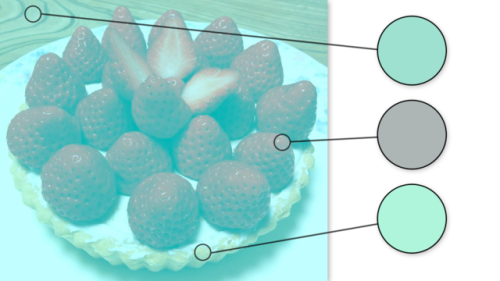
Hey resident neuroscientist @sixpenceee, wanna explain why the strawberries look red?
